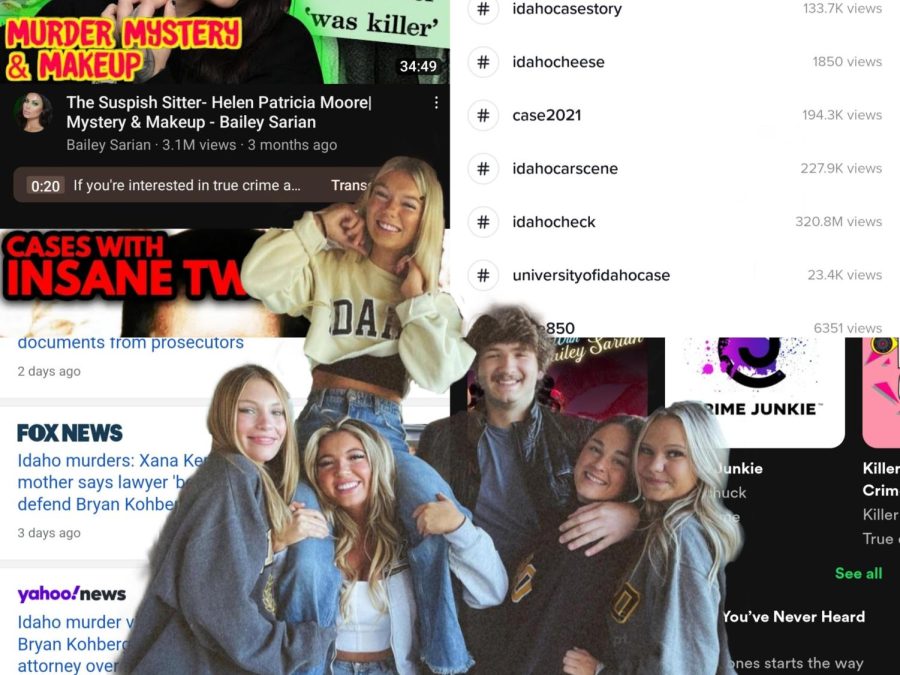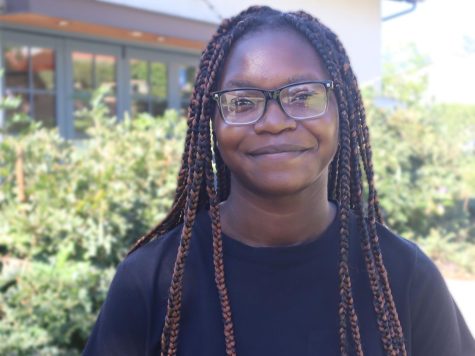On November 14th, Kacey Goncalves, Madison Mogen, Xana Kernodle, and Ethan Chapin were stabbed to death in an off-campus house in the early morning. America erupted in shock and horror as news of the gruesome murders broke in Moscow, Idaho and the case garnered media attention due to the shocking brutality, lack of motive, missing weapon and the survival of two of the roommates.
The internet immediately latched onto the case, with hundreds of users across social media platforms sharing information and discussing the details of the crime. On Instagram there are accounts dedicated to victims, and on Tik Tok, the tag “#idahomurders” alone has over 800 million views.
The attention this case has drawn created an influx of theories and amateur “internet sleuths” who believe that they can aid in solving the crime. Prior to the suspect Brian Kohberger’s capture and identification, the internet accused several innocent people of playing a role in the students’ deaths. Family members of the victims, friends, and even roommates found themselves under harsh scrutiny from people following the case.
Dylan Mortensen, a roommate to the victims, came face-to-face with Kohberger while he was in the house, and according to police reports, was in a “frozen shock phase” when she saw the killer. The police officers were called eight hours after her encounter. Due to this experience, Dylan has found herself under the microscope more than anyone else, with people criticizing her reaction and her social media posts prior to the crime.
The people who are close to the victims aren’t the only ones affected by the prying hands of social media. A self-proclaimed psychic on Tik Tok called “Ashley Solves Mysteries” had claimed that University of Idaho Professor Rebecca Scofield planned out their murder and executed the students. This accusation seemingly comes out of nowhere, but Ashley claims that she was able to “solve” the case by reading tarot cards. When people pointed out how ridiculous this is, she doubled down and insisted that her version of the truth will come to light.
This is not even the tip of the iceberg of theories and internet personalities that have emerged from the murder of the four students.
A sensationalized case, the chatter around the Idaho Murders reveals the biggest issue that social media creates — unwarranted attention and the commodification of murder. This isn’t the first time a brutal crime has received a lot of media attention – like Gaby Petito’s murder last year – but this case is different. Easy access to the case details and identities of the victims along with the rapidly growing cultural interest in true crime has led to a unique relationship between followers on the internet and the progression of the case.
America’s cultural interest in true crime has increased exponentially over the past few years. Nowadays, we see podcasts dedicated to revealing cases and crimes like “My Favorite Murder,” “Killer Queens,” “True Crime and & Cocktails.” On YouTube, you can find dozens of creators discussing the gruesome details of cases while cracking jokes and doing makeup. Not to mention the dozens of other outlets for true crime junkies: documentaries, shows, and even conventions. Everywhere you turn there are people making profit from tragedies, yet eager consumers are ready to devour the content.
The “true crime” community has received plenty of attention, and there continues to be no shortage of debates on the morality of this phenomenon.
As an observer of the Idaho case, I am inclined to lean towards a negative view. In defense of true crime, people have pointed out how it can bring attention to communities often overlooked by authorities and shed light on the injustice in our criminal justice system. Yet the people actually doing this seem to be few and far between, as the majority of the community seems to be more interested in satisfying their own morbid curiosity.
The negative effects of this true crime fever are all on display with the Idaho case, and it only seems to be getting worse. Followers of the case seem to believe themselves to be “armchair detectives”: they pour over the victim’s social media posts, the information released by the police, create theories about what happened, harass survivors for not being “perfect victims,” and eagerly await new case details as if it’s a new episode of a show being aired, rather than a tragedy unfolding before our eyes. The students and their alleged killer are reduced to characters in a crime show performing for a rapt audience.
The rise of true crime also leads to another troubling phenomenon: the glorification of the criminals. Killers are often described as “cunning,” “smart,” “manipulative.” These aren’t necessarily good descriptors, but they elevate cruel people to a sort of mastermind status.
This sends a clear message, and it might even be what some killers want. It’s important for the public to be aware of dangerous individuals, but when we sensationalize cases, give out nicknames to killers, and dedicate shows and attention to brutal crimes, we are simultaneously giving attention to the people who committed them. Why should we give notoriety and celebrity to people who destroy the lives of others?
As someone who was briefly interested in true crime, I cannot help but look at the treatment of the Idaho murders with disdain. True crime both intrigued and terrified me, and reading statements from the victims’ families made me think more critically about the content I was engaging with. This is not a game of Clue or an episode of Criminal Minds. The students — Kacey Goncalves, Madison Mogen, Xana Kernodle, and Ethan Chapin — are real people. Their families are real people. They had dreams and goals, and it is unfair of the internet and our broader culture to turn them into spectacles for ratings, clicks, and attention.







![Student loan borrowers rally near the White House for Joe Biden to cancel all student loans. Biden, pictured left, is troubled with diminishing popularity with youth as he fails to forgive all students loans as he had promised. “[Biden] kind of fumbled things even though he tried with student loan forgiveness,” said Cory Warren, humanities department faculty. “That was [the] number one campaign promise to get the youth vote.” Whether it is student loans, age, or foreign policy, what, ultimately, drives away the youth vote for Biden?](https://webbcanyonchronicle.com/wp-content/uploads/2024/03/Duan-biden-popularity-1200x675.jpeg)


